Organisational Strategy: A Case Study of Virgin Atlantic Airlines
VerifiedAdded on 2023/01/16
|9
|2724
|85
AI Summary
This report analyzes the organisational strategy of Virgin Atlantic Airlines, considering both external and internal factors. It examines the macro-environment factors, industry position, segmentation, targeting and positioning, Porter's 5 forces model, internal resources and capabilities, and stakeholder perspectives.
Contribute Materials
Your contribution can guide someone’s learning journey. Share your
documents today.
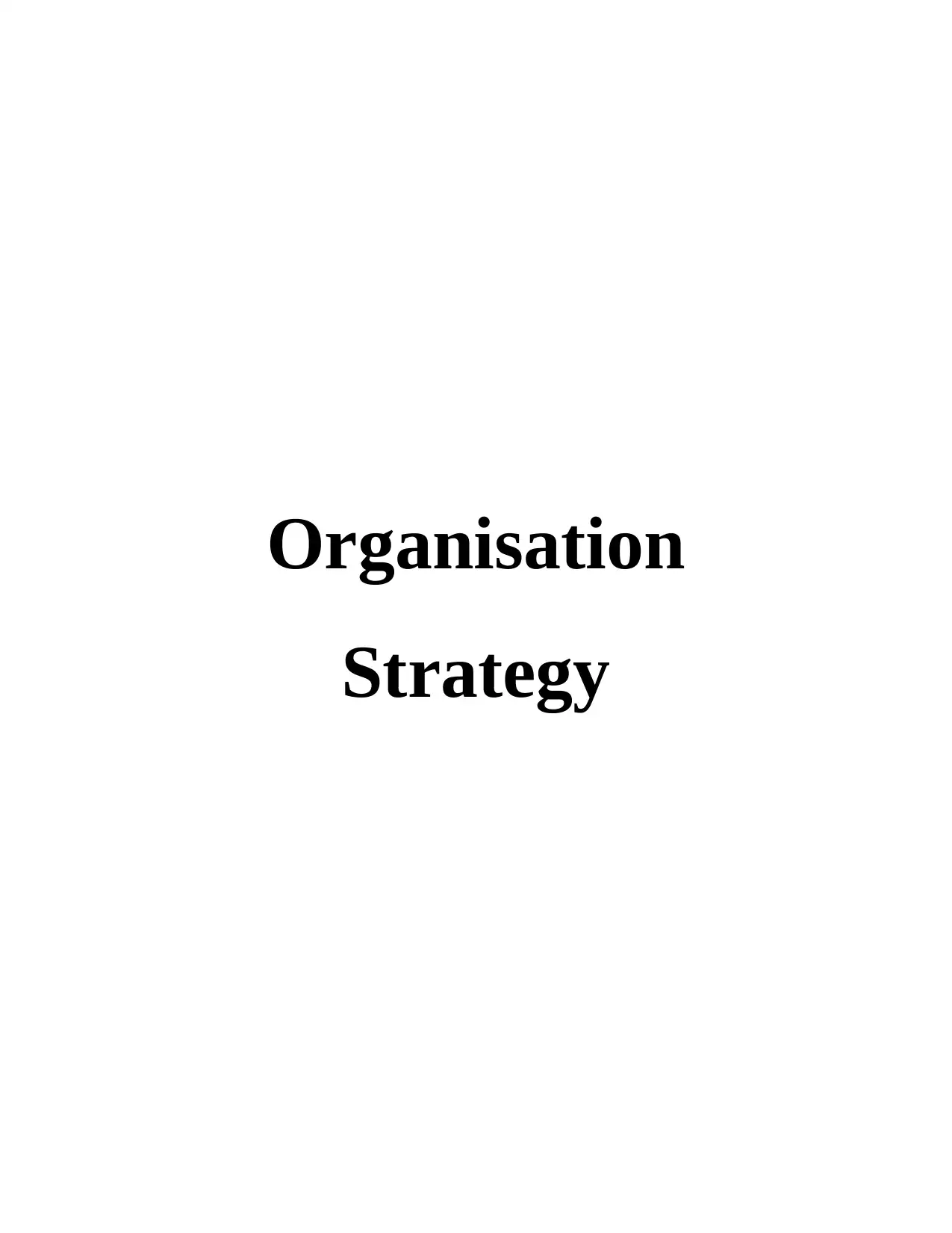
Organisation
Strategy
Strategy
Secure Best Marks with AI Grader
Need help grading? Try our AI Grader for instant feedback on your assignments.

Table of Contents
INTRODUCTION...........................................................................................................................1
PART 1............................................................................................................................................1
Macro- environment factors........................................................................................................1
Industry Position ........................................................................................................................2
Segmentation, Targeting and Positioning- ............................................................................3
Porter's 5 forces model-..........................................................................................................3
Internal resources and capabilities..............................................................................................4
Stakeholder perspectives ............................................................................................................5
CONCLUSION................................................................................................................................6
REFERENCES................................................................................................................................7
INTRODUCTION...........................................................................................................................1
PART 1............................................................................................................................................1
Macro- environment factors........................................................................................................1
Industry Position ........................................................................................................................2
Segmentation, Targeting and Positioning- ............................................................................3
Porter's 5 forces model-..........................................................................................................3
Internal resources and capabilities..............................................................................................4
Stakeholder perspectives ............................................................................................................5
CONCLUSION................................................................................................................................6
REFERENCES................................................................................................................................7
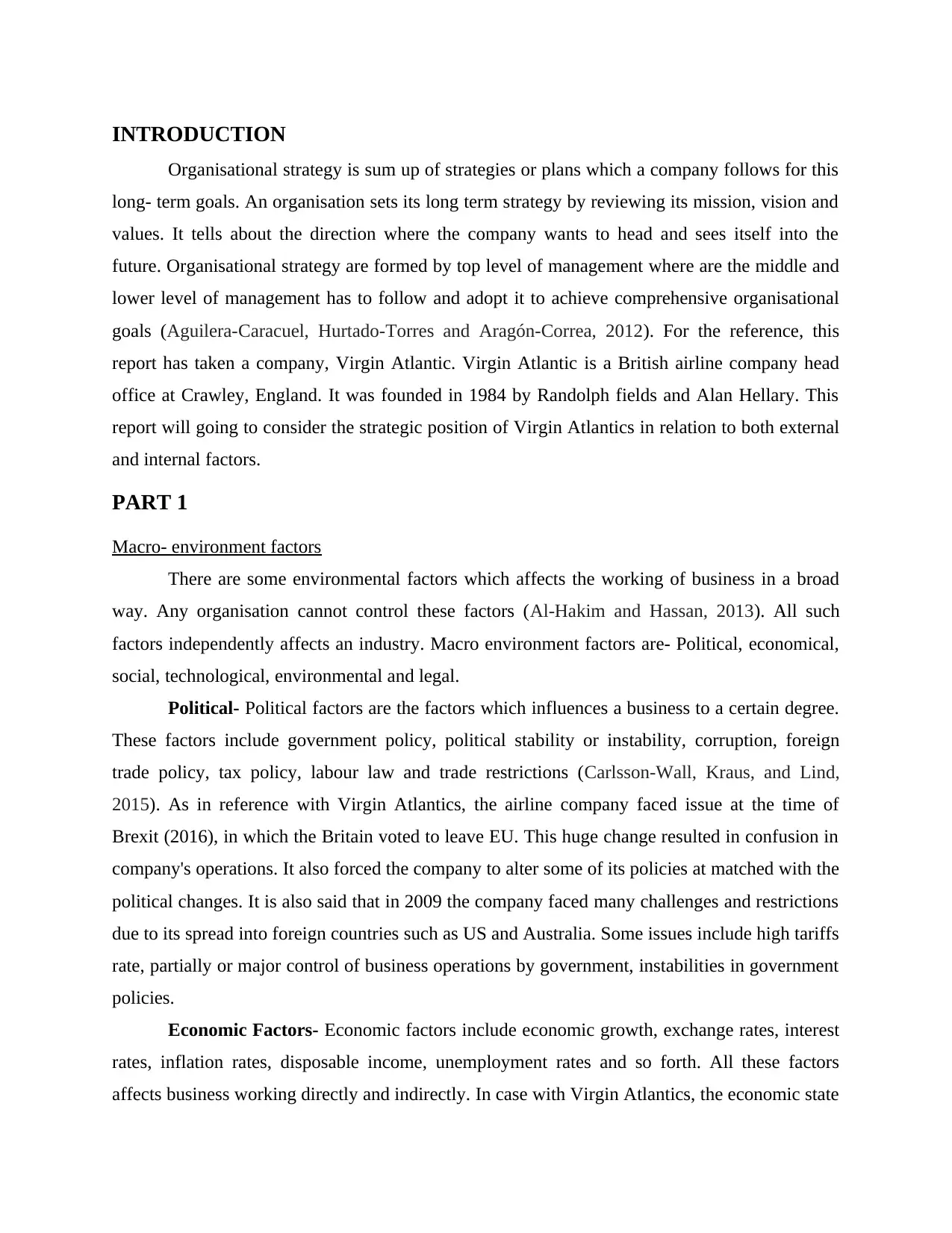
INTRODUCTION
Organisational strategy is sum up of strategies or plans which a company follows for this
long- term goals. An organisation sets its long term strategy by reviewing its mission, vision and
values. It tells about the direction where the company wants to head and sees itself into the
future. Organisational strategy are formed by top level of management where are the middle and
lower level of management has to follow and adopt it to achieve comprehensive organisational
goals (Aguilera-Caracuel, Hurtado-Torres and Aragón-Correa, 2012). For the reference, this
report has taken a company, Virgin Atlantic. Virgin Atlantic is a British airline company head
office at Crawley, England. It was founded in 1984 by Randolph fields and Alan Hellary. This
report will going to consider the strategic position of Virgin Atlantics in relation to both external
and internal factors.
PART 1
Macro- environment factors
There are some environmental factors which affects the working of business in a broad
way. Any organisation cannot control these factors (Al‐Hakim and Hassan, 2013). All such
factors independently affects an industry. Macro environment factors are- Political, economical,
social, technological, environmental and legal.
Political- Political factors are the factors which influences a business to a certain degree.
These factors include government policy, political stability or instability, corruption, foreign
trade policy, tax policy, labour law and trade restrictions (Carlsson-Wall, Kraus, and Lind,
2015). As in reference with Virgin Atlantics, the airline company faced issue at the time of
Brexit (2016), in which the Britain voted to leave EU. This huge change resulted in confusion in
company's operations. It also forced the company to alter some of its policies at matched with the
political changes. It is also said that in 2009 the company faced many challenges and restrictions
due to its spread into foreign countries such as US and Australia. Some issues include high tariffs
rate, partially or major control of business operations by government, instabilities in government
policies.
Economic Factors- Economic factors include economic growth, exchange rates, interest
rates, inflation rates, disposable income, unemployment rates and so forth. All these factors
affects business working directly and indirectly. In case with Virgin Atlantics, the economic state
Organisational strategy is sum up of strategies or plans which a company follows for this
long- term goals. An organisation sets its long term strategy by reviewing its mission, vision and
values. It tells about the direction where the company wants to head and sees itself into the
future. Organisational strategy are formed by top level of management where are the middle and
lower level of management has to follow and adopt it to achieve comprehensive organisational
goals (Aguilera-Caracuel, Hurtado-Torres and Aragón-Correa, 2012). For the reference, this
report has taken a company, Virgin Atlantic. Virgin Atlantic is a British airline company head
office at Crawley, England. It was founded in 1984 by Randolph fields and Alan Hellary. This
report will going to consider the strategic position of Virgin Atlantics in relation to both external
and internal factors.
PART 1
Macro- environment factors
There are some environmental factors which affects the working of business in a broad
way. Any organisation cannot control these factors (Al‐Hakim and Hassan, 2013). All such
factors independently affects an industry. Macro environment factors are- Political, economical,
social, technological, environmental and legal.
Political- Political factors are the factors which influences a business to a certain degree.
These factors include government policy, political stability or instability, corruption, foreign
trade policy, tax policy, labour law and trade restrictions (Carlsson-Wall, Kraus, and Lind,
2015). As in reference with Virgin Atlantics, the airline company faced issue at the time of
Brexit (2016), in which the Britain voted to leave EU. This huge change resulted in confusion in
company's operations. It also forced the company to alter some of its policies at matched with the
political changes. It is also said that in 2009 the company faced many challenges and restrictions
due to its spread into foreign countries such as US and Australia. Some issues include high tariffs
rate, partially or major control of business operations by government, instabilities in government
policies.
Economic Factors- Economic factors include economic growth, exchange rates, interest
rates, inflation rates, disposable income, unemployment rates and so forth. All these factors
affects business working directly and indirectly. In case with Virgin Atlantics, the economic state
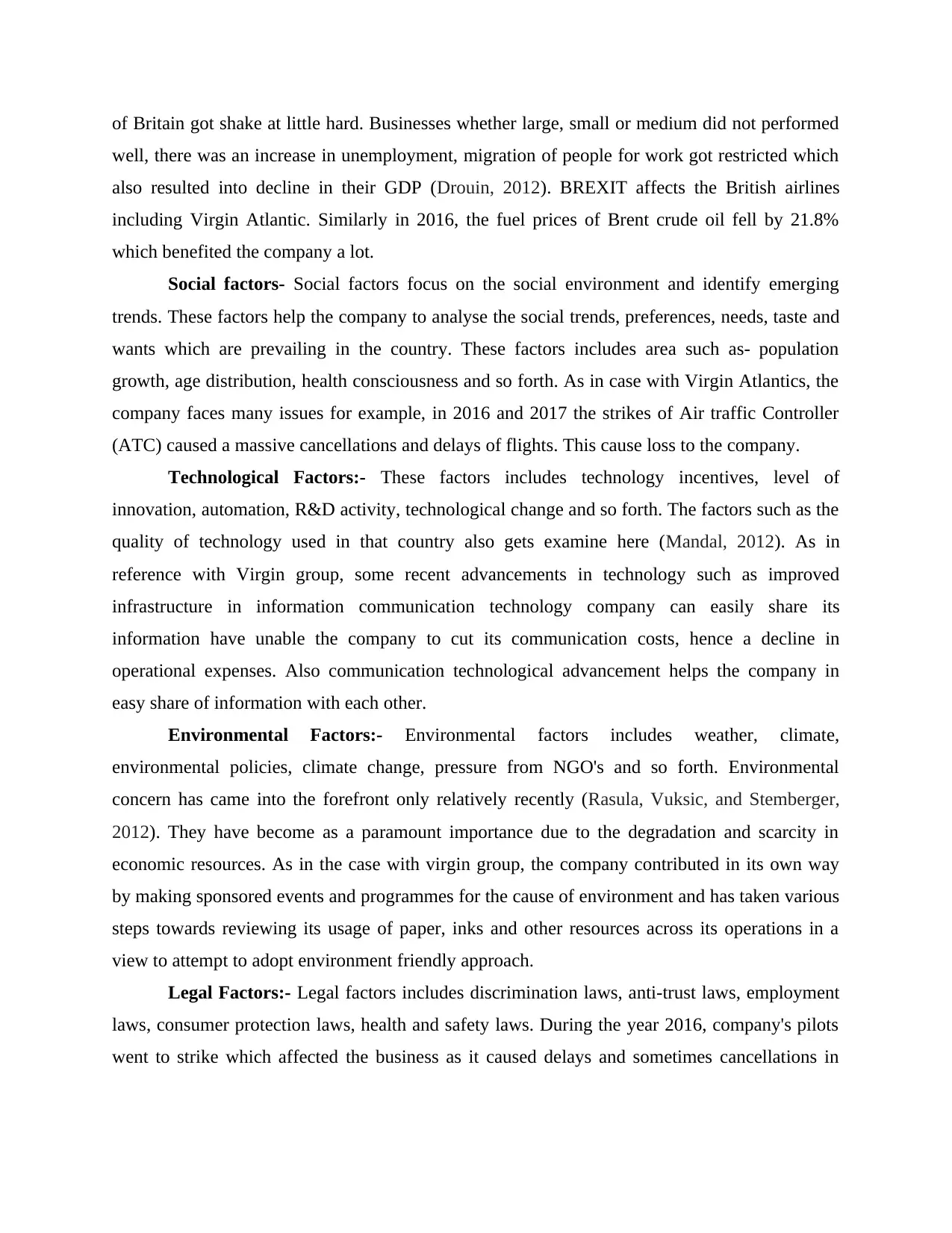
of Britain got shake at little hard. Businesses whether large, small or medium did not performed
well, there was an increase in unemployment, migration of people for work got restricted which
also resulted into decline in their GDP (Drouin, 2012). BREXIT affects the British airlines
including Virgin Atlantic. Similarly in 2016, the fuel prices of Brent crude oil fell by 21.8%
which benefited the company a lot.
Social factors- Social factors focus on the social environment and identify emerging
trends. These factors help the company to analyse the social trends, preferences, needs, taste and
wants which are prevailing in the country. These factors includes area such as- population
growth, age distribution, health consciousness and so forth. As in case with Virgin Atlantics, the
company faces many issues for example, in 2016 and 2017 the strikes of Air traffic Controller
(ATC) caused a massive cancellations and delays of flights. This cause loss to the company.
Technological Factors:- These factors includes technology incentives, level of
innovation, automation, R&D activity, technological change and so forth. The factors such as the
quality of technology used in that country also gets examine here (Mandal, 2012). As in
reference with Virgin group, some recent advancements in technology such as improved
infrastructure in information communication technology company can easily share its
information have unable the company to cut its communication costs, hence a decline in
operational expenses. Also communication technological advancement helps the company in
easy share of information with each other.
Environmental Factors:- Environmental factors includes weather, climate,
environmental policies, climate change, pressure from NGO's and so forth. Environmental
concern has came into the forefront only relatively recently (Rasula, Vuksic, and Stemberger,
2012). They have become as a paramount importance due to the degradation and scarcity in
economic resources. As in the case with virgin group, the company contributed in its own way
by making sponsored events and programmes for the cause of environment and has taken various
steps towards reviewing its usage of paper, inks and other resources across its operations in a
view to attempt to adopt environment friendly approach.
Legal Factors:- Legal factors includes discrimination laws, anti-trust laws, employment
laws, consumer protection laws, health and safety laws. During the year 2016, company's pilots
went to strike which affected the business as it caused delays and sometimes cancellations in
well, there was an increase in unemployment, migration of people for work got restricted which
also resulted into decline in their GDP (Drouin, 2012). BREXIT affects the British airlines
including Virgin Atlantic. Similarly in 2016, the fuel prices of Brent crude oil fell by 21.8%
which benefited the company a lot.
Social factors- Social factors focus on the social environment and identify emerging
trends. These factors help the company to analyse the social trends, preferences, needs, taste and
wants which are prevailing in the country. These factors includes area such as- population
growth, age distribution, health consciousness and so forth. As in case with Virgin Atlantics, the
company faces many issues for example, in 2016 and 2017 the strikes of Air traffic Controller
(ATC) caused a massive cancellations and delays of flights. This cause loss to the company.
Technological Factors:- These factors includes technology incentives, level of
innovation, automation, R&D activity, technological change and so forth. The factors such as the
quality of technology used in that country also gets examine here (Mandal, 2012). As in
reference with Virgin group, some recent advancements in technology such as improved
infrastructure in information communication technology company can easily share its
information have unable the company to cut its communication costs, hence a decline in
operational expenses. Also communication technological advancement helps the company in
easy share of information with each other.
Environmental Factors:- Environmental factors includes weather, climate,
environmental policies, climate change, pressure from NGO's and so forth. Environmental
concern has came into the forefront only relatively recently (Rasula, Vuksic, and Stemberger,
2012). They have become as a paramount importance due to the degradation and scarcity in
economic resources. As in the case with virgin group, the company contributed in its own way
by making sponsored events and programmes for the cause of environment and has taken various
steps towards reviewing its usage of paper, inks and other resources across its operations in a
view to attempt to adopt environment friendly approach.
Legal Factors:- Legal factors includes discrimination laws, anti-trust laws, employment
laws, consumer protection laws, health and safety laws. During the year 2016, company's pilots
went to strike which affected the business as it caused delays and sometimes cancellations in
Secure Best Marks with AI Grader
Need help grading? Try our AI Grader for instant feedback on your assignments.
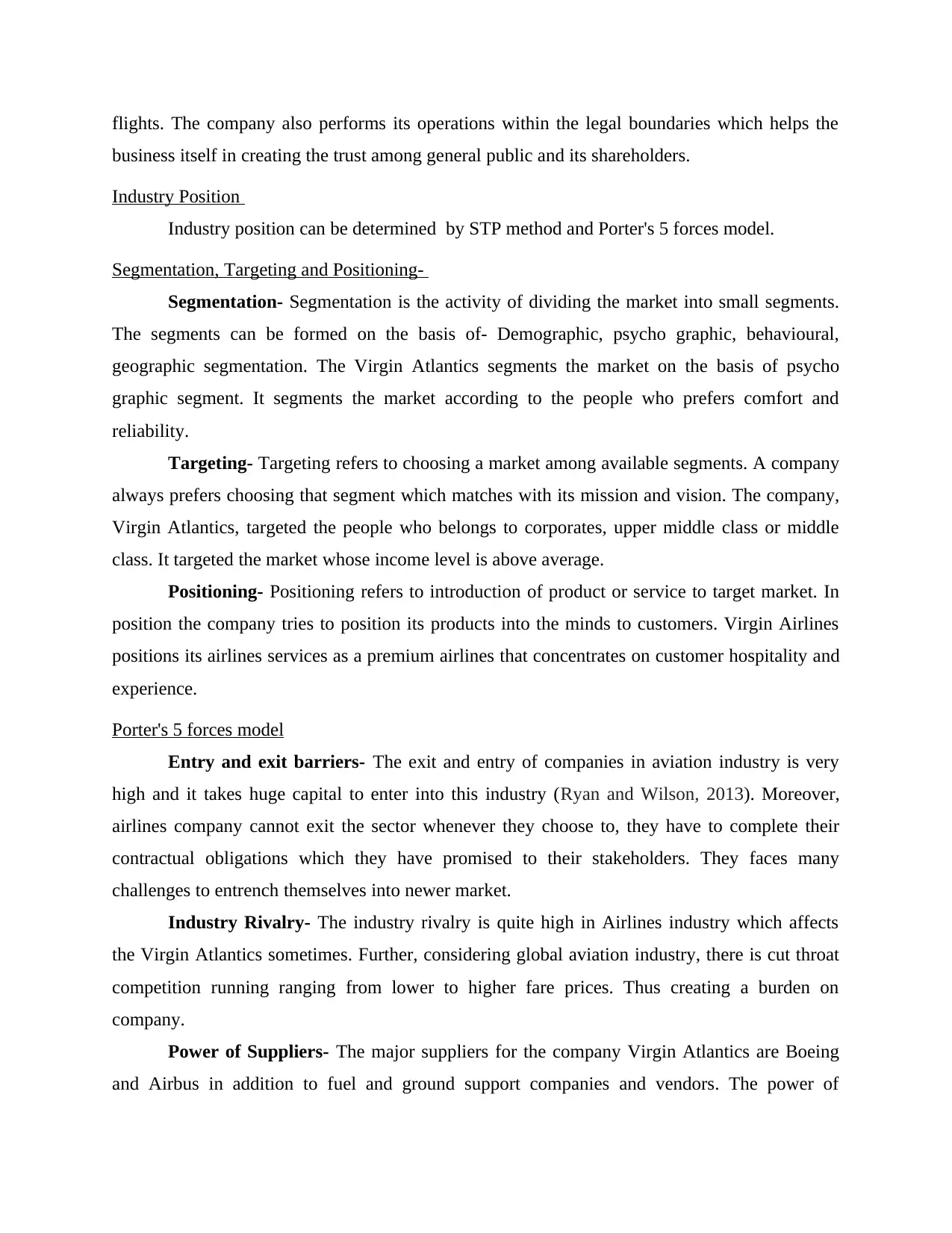
flights. The company also performs its operations within the legal boundaries which helps the
business itself in creating the trust among general public and its shareholders.
Industry Position
Industry position can be determined by STP method and Porter's 5 forces model.
Segmentation, Targeting and Positioning-
Segmentation- Segmentation is the activity of dividing the market into small segments.
The segments can be formed on the basis of- Demographic, psycho graphic, behavioural,
geographic segmentation. The Virgin Atlantics segments the market on the basis of psycho
graphic segment. It segments the market according to the people who prefers comfort and
reliability.
Targeting- Targeting refers to choosing a market among available segments. A company
always prefers choosing that segment which matches with its mission and vision. The company,
Virgin Atlantics, targeted the people who belongs to corporates, upper middle class or middle
class. It targeted the market whose income level is above average.
Positioning- Positioning refers to introduction of product or service to target market. In
position the company tries to position its products into the minds to customers. Virgin Airlines
positions its airlines services as a premium airlines that concentrates on customer hospitality and
experience.
Porter's 5 forces model
Entry and exit barriers- The exit and entry of companies in aviation industry is very
high and it takes huge capital to enter into this industry (Ryan and Wilson, 2013). Moreover,
airlines company cannot exit the sector whenever they choose to, they have to complete their
contractual obligations which they have promised to their stakeholders. They faces many
challenges to entrench themselves into newer market.
Industry Rivalry- The industry rivalry is quite high in Airlines industry which affects
the Virgin Atlantics sometimes. Further, considering global aviation industry, there is cut throat
competition running ranging from lower to higher fare prices. Thus creating a burden on
company.
Power of Suppliers- The major suppliers for the company Virgin Atlantics are Boeing
and Airbus in addition to fuel and ground support companies and vendors. The power of
business itself in creating the trust among general public and its shareholders.
Industry Position
Industry position can be determined by STP method and Porter's 5 forces model.
Segmentation, Targeting and Positioning-
Segmentation- Segmentation is the activity of dividing the market into small segments.
The segments can be formed on the basis of- Demographic, psycho graphic, behavioural,
geographic segmentation. The Virgin Atlantics segments the market on the basis of psycho
graphic segment. It segments the market according to the people who prefers comfort and
reliability.
Targeting- Targeting refers to choosing a market among available segments. A company
always prefers choosing that segment which matches with its mission and vision. The company,
Virgin Atlantics, targeted the people who belongs to corporates, upper middle class or middle
class. It targeted the market whose income level is above average.
Positioning- Positioning refers to introduction of product or service to target market. In
position the company tries to position its products into the minds to customers. Virgin Airlines
positions its airlines services as a premium airlines that concentrates on customer hospitality and
experience.
Porter's 5 forces model
Entry and exit barriers- The exit and entry of companies in aviation industry is very
high and it takes huge capital to enter into this industry (Ryan and Wilson, 2013). Moreover,
airlines company cannot exit the sector whenever they choose to, they have to complete their
contractual obligations which they have promised to their stakeholders. They faces many
challenges to entrench themselves into newer market.
Industry Rivalry- The industry rivalry is quite high in Airlines industry which affects
the Virgin Atlantics sometimes. Further, considering global aviation industry, there is cut throat
competition running ranging from lower to higher fare prices. Thus creating a burden on
company.
Power of Suppliers- The major suppliers for the company Virgin Atlantics are Boeing
and Airbus in addition to fuel and ground support companies and vendors. The power of
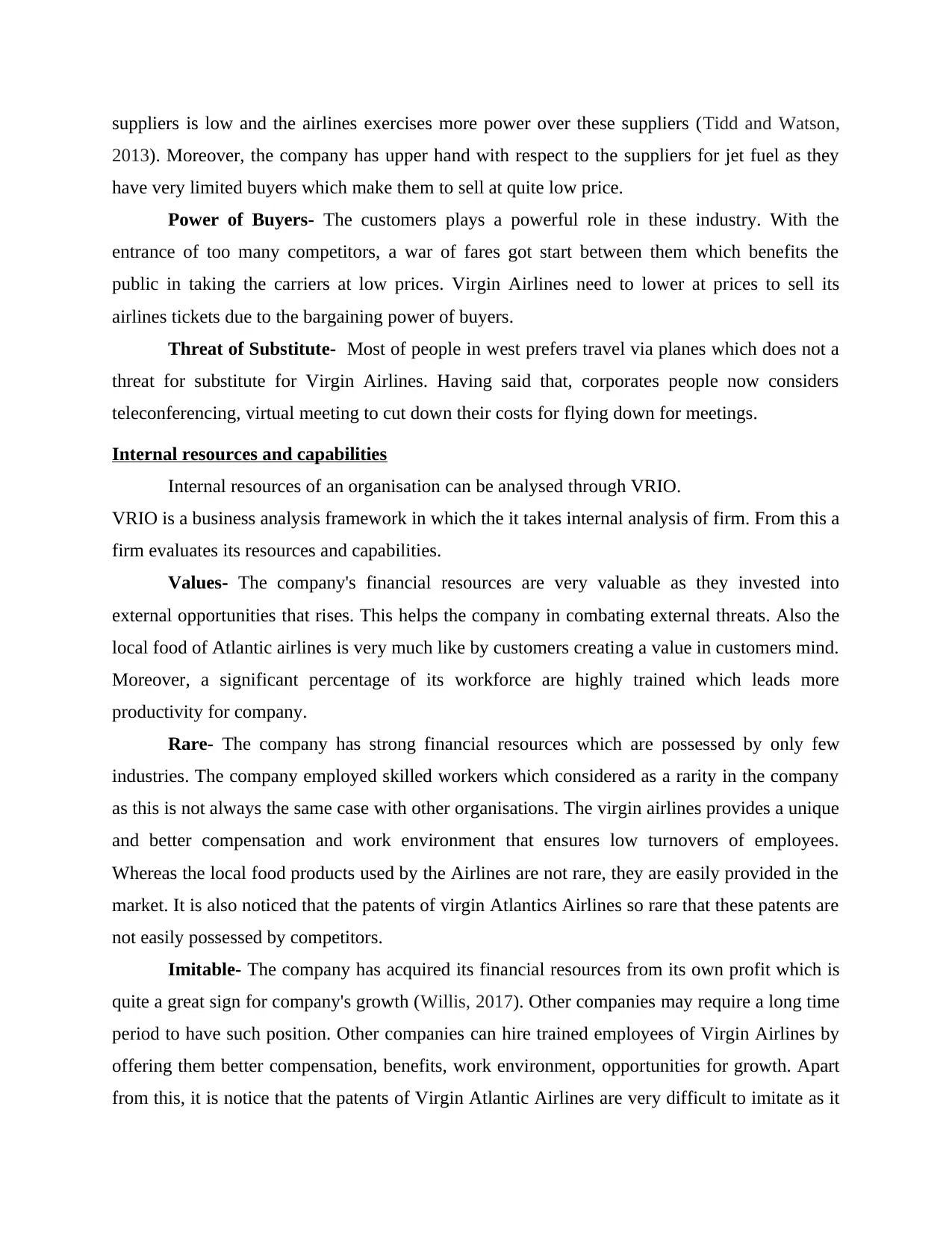
suppliers is low and the airlines exercises more power over these suppliers (Tidd and Watson,
2013). Moreover, the company has upper hand with respect to the suppliers for jet fuel as they
have very limited buyers which make them to sell at quite low price.
Power of Buyers- The customers plays a powerful role in these industry. With the
entrance of too many competitors, a war of fares got start between them which benefits the
public in taking the carriers at low prices. Virgin Airlines need to lower at prices to sell its
airlines tickets due to the bargaining power of buyers.
Threat of Substitute- Most of people in west prefers travel via planes which does not a
threat for substitute for Virgin Airlines. Having said that, corporates people now considers
teleconferencing, virtual meeting to cut down their costs for flying down for meetings.
Internal resources and capabilities
Internal resources of an organisation can be analysed through VRIO.
VRIO is a business analysis framework in which the it takes internal analysis of firm. From this a
firm evaluates its resources and capabilities.
Values- The company's financial resources are very valuable as they invested into
external opportunities that rises. This helps the company in combating external threats. Also the
local food of Atlantic airlines is very much like by customers creating a value in customers mind.
Moreover, a significant percentage of its workforce are highly trained which leads more
productivity for company.
Rare- The company has strong financial resources which are possessed by only few
industries. The company employed skilled workers which considered as a rarity in the company
as this is not always the same case with other organisations. The virgin airlines provides a unique
and better compensation and work environment that ensures low turnovers of employees.
Whereas the local food products used by the Airlines are not rare, they are easily provided in the
market. It is also noticed that the patents of virgin Atlantics Airlines so rare that these patents are
not easily possessed by competitors.
Imitable- The company has acquired its financial resources from its own profit which is
quite a great sign for company's growth (Willis, 2017). Other companies may require a long time
period to have such position. Other companies can hire trained employees of Virgin Airlines by
offering them better compensation, benefits, work environment, opportunities for growth. Apart
from this, it is notice that the patents of Virgin Atlantic Airlines are very difficult to imitate as it
2013). Moreover, the company has upper hand with respect to the suppliers for jet fuel as they
have very limited buyers which make them to sell at quite low price.
Power of Buyers- The customers plays a powerful role in these industry. With the
entrance of too many competitors, a war of fares got start between them which benefits the
public in taking the carriers at low prices. Virgin Airlines need to lower at prices to sell its
airlines tickets due to the bargaining power of buyers.
Threat of Substitute- Most of people in west prefers travel via planes which does not a
threat for substitute for Virgin Airlines. Having said that, corporates people now considers
teleconferencing, virtual meeting to cut down their costs for flying down for meetings.
Internal resources and capabilities
Internal resources of an organisation can be analysed through VRIO.
VRIO is a business analysis framework in which the it takes internal analysis of firm. From this a
firm evaluates its resources and capabilities.
Values- The company's financial resources are very valuable as they invested into
external opportunities that rises. This helps the company in combating external threats. Also the
local food of Atlantic airlines is very much like by customers creating a value in customers mind.
Moreover, a significant percentage of its workforce are highly trained which leads more
productivity for company.
Rare- The company has strong financial resources which are possessed by only few
industries. The company employed skilled workers which considered as a rarity in the company
as this is not always the same case with other organisations. The virgin airlines provides a unique
and better compensation and work environment that ensures low turnovers of employees.
Whereas the local food products used by the Airlines are not rare, they are easily provided in the
market. It is also noticed that the patents of virgin Atlantics Airlines so rare that these patents are
not easily possessed by competitors.
Imitable- The company has acquired its financial resources from its own profit which is
quite a great sign for company's growth (Willis, 2017). Other companies may require a long time
period to have such position. Other companies can hire trained employees of Virgin Airlines by
offering them better compensation, benefits, work environment, opportunities for growth. Apart
from this, it is notice that the patents of Virgin Atlantic Airlines are very difficult to imitate as it
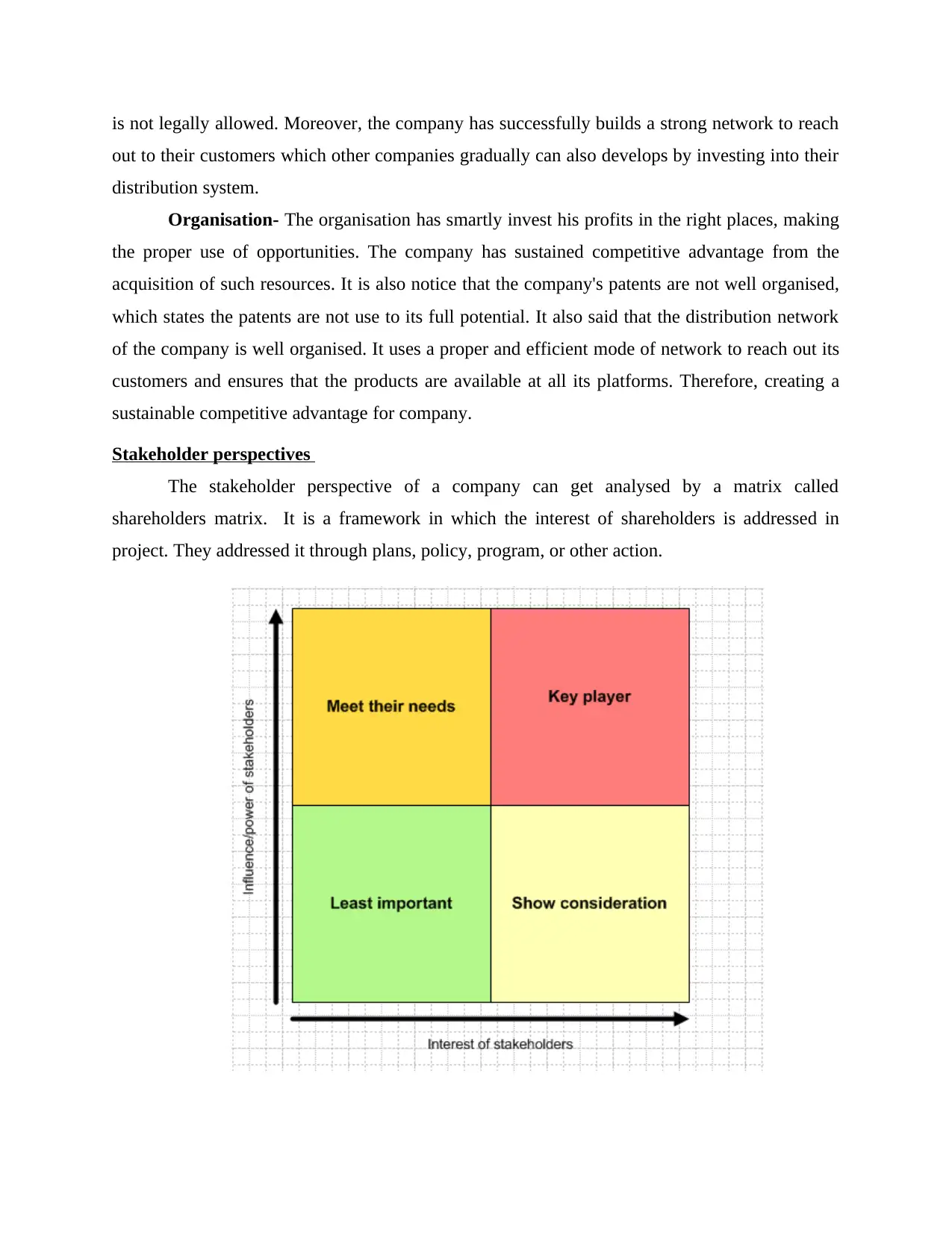
is not legally allowed. Moreover, the company has successfully builds a strong network to reach
out to their customers which other companies gradually can also develops by investing into their
distribution system.
Organisation- The organisation has smartly invest his profits in the right places, making
the proper use of opportunities. The company has sustained competitive advantage from the
acquisition of such resources. It is also notice that the company's patents are not well organised,
which states the patents are not use to its full potential. It also said that the distribution network
of the company is well organised. It uses a proper and efficient mode of network to reach out its
customers and ensures that the products are available at all its platforms. Therefore, creating a
sustainable competitive advantage for company.
Stakeholder perspectives
The stakeholder perspective of a company can get analysed by a matrix called
shareholders matrix. It is a framework in which the interest of shareholders is addressed in
project. They addressed it through plans, policy, program, or other action.
out to their customers which other companies gradually can also develops by investing into their
distribution system.
Organisation- The organisation has smartly invest his profits in the right places, making
the proper use of opportunities. The company has sustained competitive advantage from the
acquisition of such resources. It is also notice that the company's patents are not well organised,
which states the patents are not use to its full potential. It also said that the distribution network
of the company is well organised. It uses a proper and efficient mode of network to reach out its
customers and ensures that the products are available at all its platforms. Therefore, creating a
sustainable competitive advantage for company.
Stakeholder perspectives
The stakeholder perspective of a company can get analysed by a matrix called
shareholders matrix. It is a framework in which the interest of shareholders is addressed in
project. They addressed it through plans, policy, program, or other action.
Paraphrase This Document
Need a fresh take? Get an instant paraphrase of this document with our AI Paraphraser
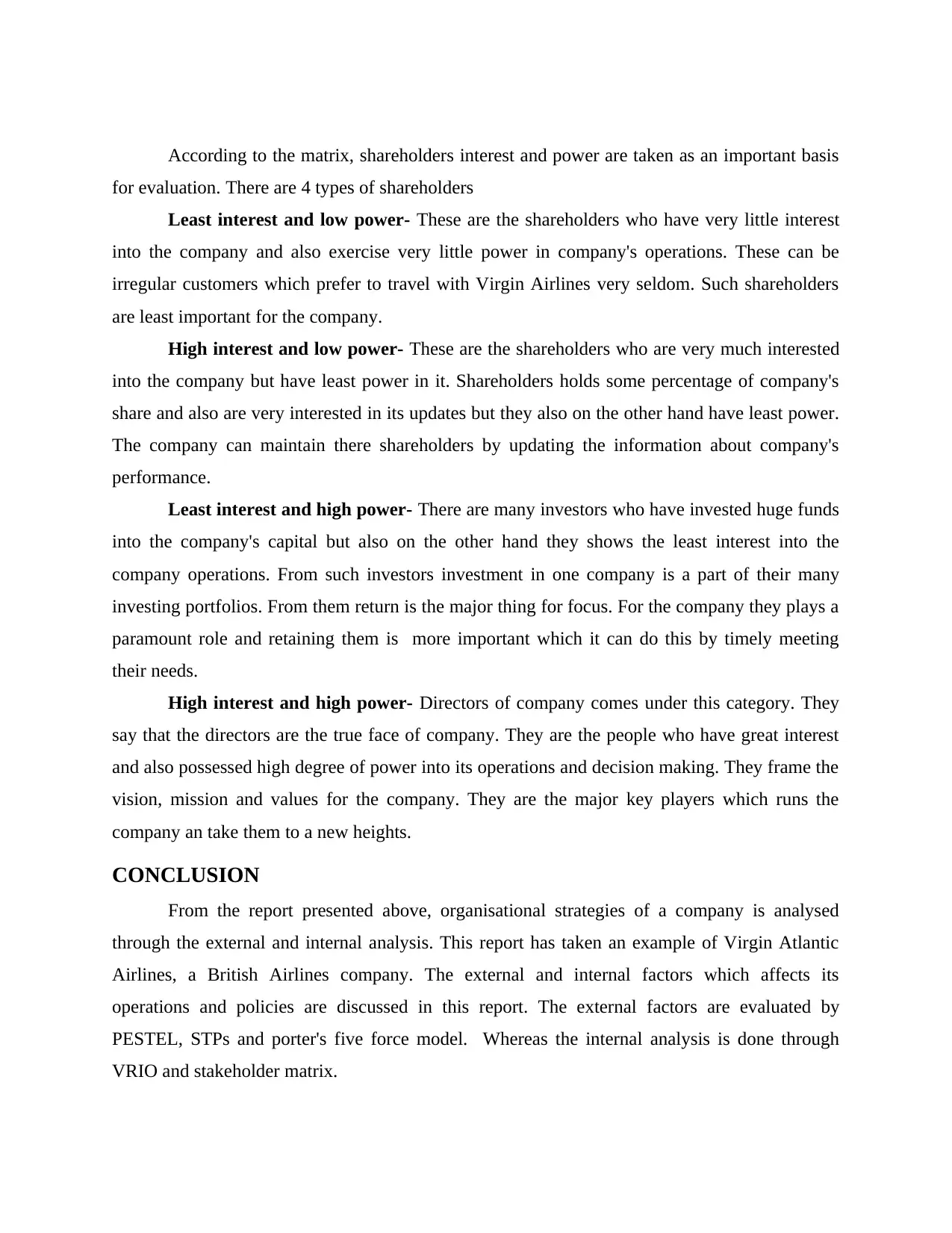
According to the matrix, shareholders interest and power are taken as an important basis
for evaluation. There are 4 types of shareholders
Least interest and low power- These are the shareholders who have very little interest
into the company and also exercise very little power in company's operations. These can be
irregular customers which prefer to travel with Virgin Airlines very seldom. Such shareholders
are least important for the company.
High interest and low power- These are the shareholders who are very much interested
into the company but have least power in it. Shareholders holds some percentage of company's
share and also are very interested in its updates but they also on the other hand have least power.
The company can maintain there shareholders by updating the information about company's
performance.
Least interest and high power- There are many investors who have invested huge funds
into the company's capital but also on the other hand they shows the least interest into the
company operations. From such investors investment in one company is a part of their many
investing portfolios. From them return is the major thing for focus. For the company they plays a
paramount role and retaining them is more important which it can do this by timely meeting
their needs.
High interest and high power- Directors of company comes under this category. They
say that the directors are the true face of company. They are the people who have great interest
and also possessed high degree of power into its operations and decision making. They frame the
vision, mission and values for the company. They are the major key players which runs the
company an take them to a new heights.
CONCLUSION
From the report presented above, organisational strategies of a company is analysed
through the external and internal analysis. This report has taken an example of Virgin Atlantic
Airlines, a British Airlines company. The external and internal factors which affects its
operations and policies are discussed in this report. The external factors are evaluated by
PESTEL, STPs and porter's five force model. Whereas the internal analysis is done through
VRIO and stakeholder matrix.
for evaluation. There are 4 types of shareholders
Least interest and low power- These are the shareholders who have very little interest
into the company and also exercise very little power in company's operations. These can be
irregular customers which prefer to travel with Virgin Airlines very seldom. Such shareholders
are least important for the company.
High interest and low power- These are the shareholders who are very much interested
into the company but have least power in it. Shareholders holds some percentage of company's
share and also are very interested in its updates but they also on the other hand have least power.
The company can maintain there shareholders by updating the information about company's
performance.
Least interest and high power- There are many investors who have invested huge funds
into the company's capital but also on the other hand they shows the least interest into the
company operations. From such investors investment in one company is a part of their many
investing portfolios. From them return is the major thing for focus. For the company they plays a
paramount role and retaining them is more important which it can do this by timely meeting
their needs.
High interest and high power- Directors of company comes under this category. They
say that the directors are the true face of company. They are the people who have great interest
and also possessed high degree of power into its operations and decision making. They frame the
vision, mission and values for the company. They are the major key players which runs the
company an take them to a new heights.
CONCLUSION
From the report presented above, organisational strategies of a company is analysed
through the external and internal analysis. This report has taken an example of Virgin Atlantic
Airlines, a British Airlines company. The external and internal factors which affects its
operations and policies are discussed in this report. The external factors are evaluated by
PESTEL, STPs and porter's five force model. Whereas the internal analysis is done through
VRIO and stakeholder matrix.

REFERENCES
Books and Journals
Aguilera-Caracuel, J., Hurtado-Torres, N. E. and Aragón-Correa, J. A., 2012. Does international
experience help firms to be green? A knowledge-based view of how international
experience and organisational learning influence proactive environmental strategies.
International Business Review. 21(5). pp.847-861.
Al‐Hakim, L. A. Y. and Hassan, S., 2013. Knowledge management strategies, innovation, and
organisational performance. Journal of Advances in Management Research.
Brown, A., 2014. Organisational paradigms and sustainability in excellence. International
Journal of Quality and Service Sciences.
Carlsson-Wall, M., Kraus, K. and Lind, J., 2015. Strategic management accounting in close inter-
organisational relationships. Accounting and Business Research. 45(1). pp.27-54.
Drouin, N. and et. al., 2012. Organisational project management as a function within the
organisation. International Journal of Managing Projects in Business.
Johnson, G., 2016. Exploring strategy: text and cases. Pearson Education.
Mandal, P. and et. al., 2012. The impact of organisational strategy, culture, people and
technology management on organisational practice and performance: an empirical
analysis. International Journal of Information Systems and Change Management. 6(2).
pp.160-176.
Rasula, J., Vuksic, V.B. and Stemberger, M.I., 2012. The impact of knowledge management on
organisational performance. Economic and Business Review for Central and South-
Eastern Europe. 14(2). p.147.
Ryan, B. and Wilson, J. R., 2013. Ergonomics in the development and implementation of
organisational strategy for sustainability. Ergonomics. 56(3). pp.541-555.
Tidd, J., 2012. From knowledge management to strategic competence: assessing technological,
market and organisational innovation. World Scientific Publishing Co. Pte. Ltd..
Watson, T., 2013. Management Organization and Employment Strategy (RLE: Organizations):
New Directions in Theory and Practice. Routledge.
Willis, C. and et. al., 2017. Guidance for organisational strategy on knowledge to action from
conceptual frameworks and practice. Evidence & Policy: A Journal of Research,
Debate and Practice. 13(2). pp.317-341.
Books and Journals
Aguilera-Caracuel, J., Hurtado-Torres, N. E. and Aragón-Correa, J. A., 2012. Does international
experience help firms to be green? A knowledge-based view of how international
experience and organisational learning influence proactive environmental strategies.
International Business Review. 21(5). pp.847-861.
Al‐Hakim, L. A. Y. and Hassan, S., 2013. Knowledge management strategies, innovation, and
organisational performance. Journal of Advances in Management Research.
Brown, A., 2014. Organisational paradigms and sustainability in excellence. International
Journal of Quality and Service Sciences.
Carlsson-Wall, M., Kraus, K. and Lind, J., 2015. Strategic management accounting in close inter-
organisational relationships. Accounting and Business Research. 45(1). pp.27-54.
Drouin, N. and et. al., 2012. Organisational project management as a function within the
organisation. International Journal of Managing Projects in Business.
Johnson, G., 2016. Exploring strategy: text and cases. Pearson Education.
Mandal, P. and et. al., 2012. The impact of organisational strategy, culture, people and
technology management on organisational practice and performance: an empirical
analysis. International Journal of Information Systems and Change Management. 6(2).
pp.160-176.
Rasula, J., Vuksic, V.B. and Stemberger, M.I., 2012. The impact of knowledge management on
organisational performance. Economic and Business Review for Central and South-
Eastern Europe. 14(2). p.147.
Ryan, B. and Wilson, J. R., 2013. Ergonomics in the development and implementation of
organisational strategy for sustainability. Ergonomics. 56(3). pp.541-555.
Tidd, J., 2012. From knowledge management to strategic competence: assessing technological,
market and organisational innovation. World Scientific Publishing Co. Pte. Ltd..
Watson, T., 2013. Management Organization and Employment Strategy (RLE: Organizations):
New Directions in Theory and Practice. Routledge.
Willis, C. and et. al., 2017. Guidance for organisational strategy on knowledge to action from
conceptual frameworks and practice. Evidence & Policy: A Journal of Research,
Debate and Practice. 13(2). pp.317-341.
1 out of 9
Related Documents
Your All-in-One AI-Powered Toolkit for Academic Success.
+13062052269
info@desklib.com
Available 24*7 on WhatsApp / Email
![[object Object]](/_next/static/media/star-bottom.7253800d.svg)
Unlock your academic potential
© 2024 | Zucol Services PVT LTD | All rights reserved.





